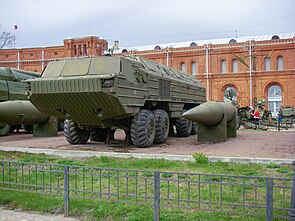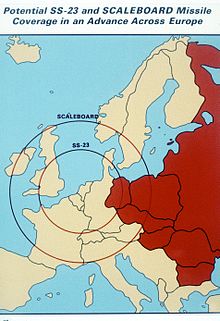SS-23 Spider
| SS-23 Spider | |
|---|---|
| General Information | |
| Type | Short-range missile |
| Local name | OTR-23 Oka, 9K714, R-400 |
| NATO designation | SS-23 Spider |
| Country of origin |
|
| Manufacturer | KBM design office , Kolomna |
| development | 1971 |
| Commissioning | 1980 |
| Working time | 1980-1991 |
| Technical specifications | |
| length | 7.53 m |
| diameter | 914 mm |
| Combat weight | 4,690 kg |
| drive | Solid rocket engine |
| speed | Mach 8.6 |
| Range | 480 km |
| Furnishing | |
| steering | INS |
| Warhead | AA-75 nuclear warhead 10–50 kt |
| Weapon platforms | BAZ-6944 truck |
| Lists on the subject | |
The SS-23 Spider was a tactical- purpose ballistic surface-to-surface missile developed and produced in the Soviet Union . It belonged to the short-range missile class (SRBM). The GRAY index was OTR-23 Oka . The system index of the Russian armed forces was R-400 Oka , the guided missile was designated 9M714 .
development
The SS-23 was designed as a successor to the 9K72 Elbrus . In 1971, the system development began in the Kolomna KBM design office . The first test launch took place in 1976. The SS-23 was introduced into the Soviet Army in 1980 . In the years that followed, 127 launch and transport vehicles and 239 guided missiles were manufactured.
variants
- 9K714 Oka: standard version.
- 9K714U Oka-U: Improved version with 9M714U missile with end-phase guidance system. Project canceled in 1987.
- Volga: project of a two-stage 9M714V missile. Project canceled.
- Sfera: Research rocket for microgravity experiments based on the 9M714 rocket.
Missiles
Three types of guided missiles were produced at the Kolomna KBM factory:
- The version 9M714B with the AA-75 (9N74B) nuclear warhead with a variable explosive power of 10–50 kT . The range was 480 kilometers.
- The version 9M714B1 with the AA-92 (9N63) nuclear warhead with a variable explosive power of 100–200 kT. The range was 400–450 kilometers.
- The version 9M714K with a 715 kilogram 9N74K warhead with 95 9N225 bombs ( cluster munitions ). The range was around 300 kilometers.
technology
The system was housed on the all-terrain BAZ-6944 Osnowa truck. The Russian Armed Forces system index for this vehicle was 9P71. The system was highly mobile and quick to lay. A minimum reaction time from full speed to the rocket firing of less than six minutes was achieved. Each vehicle was armed with a 9M714 missile.
The SS-23 was powered by a cartridge-type solid propellant , which accelerated the rocket to a maximum speed of Mach 8.6. During the acceleration phase (English boost phase ), the inertial navigation platform determined any course corrections and transmits them to four swivel nozzles and four honeycomb-shaped grid fins which change their angle of attack accordingly . After the acceleration phase, the thrust was terminated and the warhead was separated from the rocket by means of brake engines . The onward flight of the warhead now took place without steering or propulsion on the trajectory of a trajectory parabola . A hit accuracy ( CEP ) of 50-350 meters was achieved.
The 9N74K cluster munitions warhead of the 9M714K should open at an altitude of 3,000 m and distribute the cluster munitions in a circular area with a radius of 160-180 m. A 9N225 bomblet was 330 mm long and weighed 3.84 kg, of which 0.64 kg was the explosives. When detonated, it produced around 300 fragments of 5 g each .
The SS-23 had a whole range of systems for overcoming enemy defensive measures. It had a flat semi-ballistic trajectory . At the maximum shooting distance of the SS-23 (around 480 kilometers), the apogee was only 120 kilometers. Such a flat trajectory made target acquisition by search radars difficult . During the final phase of the target approach ( reentry ), a jammer weighing about 30 kilograms was activated on board, which was coordinated with the fire control radar of the MIM-104 Patriot .
The improved version 9K714U should be equipped with a radar end-phase steering system. This contained a digitally working radar system in the tip of the guided weapon. On its final approach to the target, the radar system automatically steered the rocket towards a point that was previously marked on a digital radar satellite map. With this additional system, a precision ( CEP ) of 30–50 meters should be achieved. The project was not pursued any further and ended in 1987.
Stationings
During the 1980s, the SS-23 was stationed in the Soviet Union on the territory of Ukraine and Belarus , as well as with the troop contingents of the Soviet Army stationed in the Soviet Army Group in Germany (GDR), ČSSR and Poland . A number of these systems have also been introduced in the ČSSR and Bulgaria . The GDR's National People's Army received four SS-23 launch ramps in 1985, stationed in Demen . Soviet stationing locations in the GDR were Jena Forest with 12 launch systems and 47 missiles and Weißenfels with four launch systems and six missiles. Around 33 SS-23 missiles were also stored in Ladushkin in Kaliningrad Oblast .
In the course of the INF disarmament agreement ( Intermediate-Range Nuclear Forces ), the SS-23 was retired and scrapped.
distribution
-
 Soviet Union : Scrapped under INF disarmament agreement
Soviet Union : Scrapped under INF disarmament agreement -
 German Democratic Republic : scrapped in the early 1990s
German Democratic Republic : scrapped in the early 1990s -
 Bulgaria : Retired and scrapped in 2002
Bulgaria : Retired and scrapped in 2002 -
 Czechoslovakia : Passed on to the successor states
Czechoslovakia : Passed on to the successor states
-
 Czech Republic : scrapped in the mid-1990s
Czech Republic : scrapped in the mid-1990s -
 Slovakia : Retired and scrapped in 2000
Slovakia : Retired and scrapped in 2000
-
See also
literature
- Fiszer Michal & Gruszczynski Jerzy: Bolt From the Blue - Russian land-based precision-strike missiles. Journal of Electronic Defense, March 2003.
- Schmucker Robert & Schiller Markus: Missile Threat 2.0: Technical and Political Basics . Mittler Verlag, 2015, ISBN 3-8132-0956-3 .
Web links
Individual evidence
- ↑ a b c Fiszer Michal & Gruszczynski Jerzy: Bolt From the Blue - Russian land-based precision-strike missiles. Journal of Electronic Defense. 2003. pp. 12-14.
- ↑ Missile Complex 9K714 Oka. In: rwd-mb3.de. Missile and Weapons Technical Service in Kdo.MB III, accessed on January 5, 2019 .
- ^ A b Schmucker Robert & Schiller Markus: Missile Threat 2.0: Technical and Political Basics . 2015. p. 353.
- ↑ Sigurd Hess: NVA still used nuclear weapons in 1990 . In: Marineforum 7 / 8-1999 p.3f
- ↑ Harald Nielsen: The GDR and the nuclear weapons, The nuclear role of the National People's Army in the Warsaw Pact . Nuclear History Program, International Politics and Security Volume 30/6, ed. from the Foundation Science and Politics Ebenhausen, Baden-Baden 1998
- ↑ TREATY BETWEEN THE UNITED STATES OF AMERICA AND THE UNION OF SOVIET SOCIALIST REPUBLICS ON THE ELIMINATION OF THEIR INTERMEDIATE-RANGE AND SHORTER-RANGE MISSILES ( Memento of the original from October 10, 2007 in the Internet Archive ) Info: The archive link was automatically inserted and still Not checked. Please check the original and archive link according to the instructions and then remove this notice.
- ↑ https://www.state.gov/t/avc/trty/102360.htm


